Breaking Bad Gets the Tumblr Treatment
By Sylvie Moran
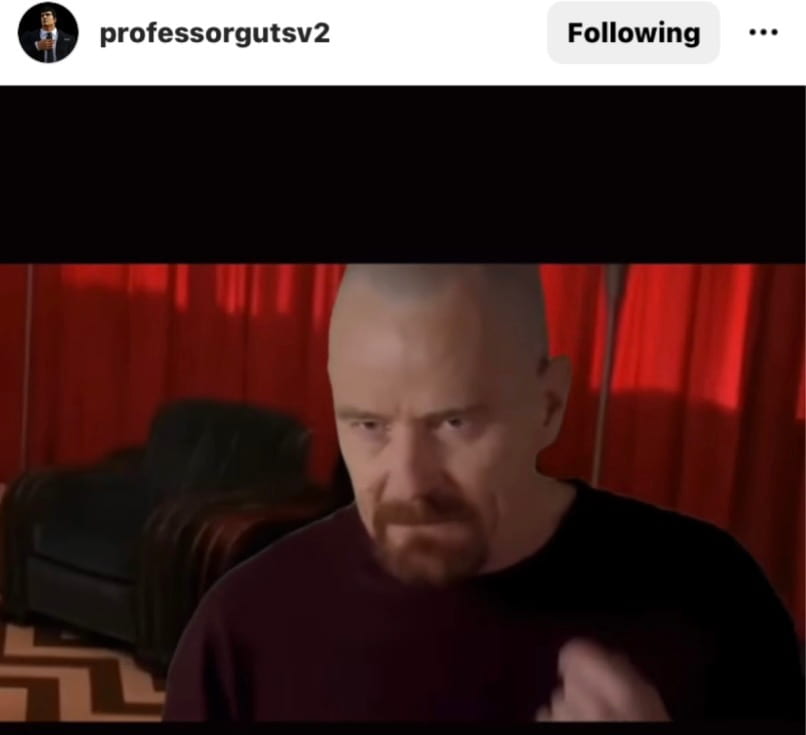
“Breaking Bad” is back, although you already know that. If you inhabit, even peripherally, the same spheres of the internet as I do, you too have probably seen the same proliferation of “Breaking Bad” memes. The prestige drama series, which ran between 2008 and 2013, had an important place in online meme culture since its debut, but lately it’s beginning to feel more and more like an essential thread in the fabric of the internet. The show’s many beloved characters—from Jesse, the goofy stoner turned hardened criminal with a heart of gold, to Gus, the steely but ever fashionable drug kingpin, and many, many more—seem to have found their ways into memes across a wide variety of fandom spaces. Video edits across social media place show protagonist, Walter White, in spaces as disparate as Mario Kart to “Twin Peaks”’ Black Lodge; the underhanded lawyer and star of his own (even better) spinoff, Saul Goodman, appears in memes from the new anime series “Chainsaw Man;” even the stoic gangster and bodyguard, Mike, can be found giving advice about Minecraft. These posts—from Twitter jokes, to Instagram memes, to TikTok videos, regularly gain hundreds of thousands of likes, and even more views. It almost feels as if “Breaking Bad” has reached a new level of fandom, one that has developed an entire visual language of memes around itself, applicable in nearly any other fandom context. What if you wanted to see Jesse and Garfield smoking a blunt together? There’s a post of it. Want to see Walter and Jesse cook as LEGO characters? There’s a whole account for that. How about Saul Goodman sitting down with Jerry Seinfeld? I actually haven’t seen that one yet, but you get the idea.
Even the cast of “Breaking Bad” seems to be aware of their newfound status as meme inspiration from across the internet. Dean Norris, who plays the antagonistic DEA agent, Hank, has made a name for himself on the app Cameo, where users can pay various celebrities for a quick customized message. One TikTok account, @breakingbadcomedy, regularly reposts Norris’ Cameos, gathering over 100,000 followers and three million views. Norris himself seems to have taken the memes in stride, despite most of his Cameo requests apparently coming from teenage boys who want to hear him crack jokes about meth and mispronounce the names of various anime characters. At a recent Comic Convention in Salt Lake City, Giancarlo Esposito, the actor of drug kingpin Gus Fring, was filmed responding to a question about his reaction to the resurgence of “Breaking Bad” memes. He amicably replies that he enjoys the ones his daughters send him, and notes that he finds it “a way to have a good laugh about a very intense and wonderful show.”
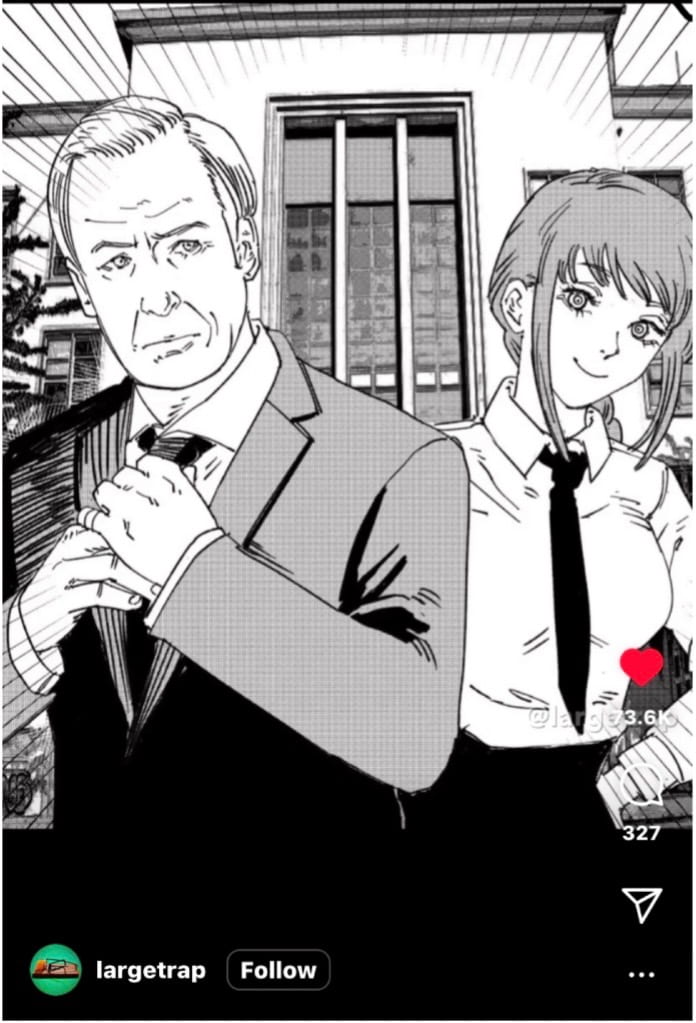
Why is a show that ended its run nearly a decade ago having such a renaissance? There are some obvious explanations, like critically acclaimed spinoff “Better Call Saul” ending its six season run this past August, or the show’s already significant place in meme culture dating back to the days of top-text-bottom-text memes. These factors, even together, don’t seem to warrant the veritable explosion in “Breaking Bad” content the internet has witnessed over the past few months. Understanding the source of the show’s current cultural revival, however, first requires a reexamination of “Breaking Bad”’s original fanbase.
The significant cultural disparity between the original and current fanbase is best summarized by user @fakesarahgoth’s tweet from October of 2022. Beyond the barely exaggerated humor here, she helpfully points to one of the two factors that primarily distinguished the earlier fanbase—violent misogyny and an absolute worship of machismo. Memes most commonly either celebrated Walter White’s hypermasculine cool, or displayed a venomous hatred for his wife, Skyler White. YouTuber Jack Saint’s 2019 video essay, “Why You Hate Skyler White,” begins with an over two minute long compilation of Reddit comments expressing such feelings, ranging from calling her all manner of misogynistic slurs, to describing the actress who played her, Anna Gunn, as “one of those man-women.” Gunn herself received nearly as much hate as her character, including death threats. In 2013, the New York Times published a brief op-ed by her, titled “I Have a Character Issue.” The article, while calling attention to the level of misogynist rhetoric surrounding her and her role, ultimately feels like a lukewarm condemnation of the fans’ misogyny. The article concludes with Gunn claiming that, at the end of the day, she was “glad that this discussion happened.” Platitudes like this downplay the horror logical leap—that an actor should have to pay for the issues of her character—with her life, no less. These threats were only the pinnacle of the fans’ misogyny, fostered by a community that idolized Walter White and his hypermasculine displays of violence.
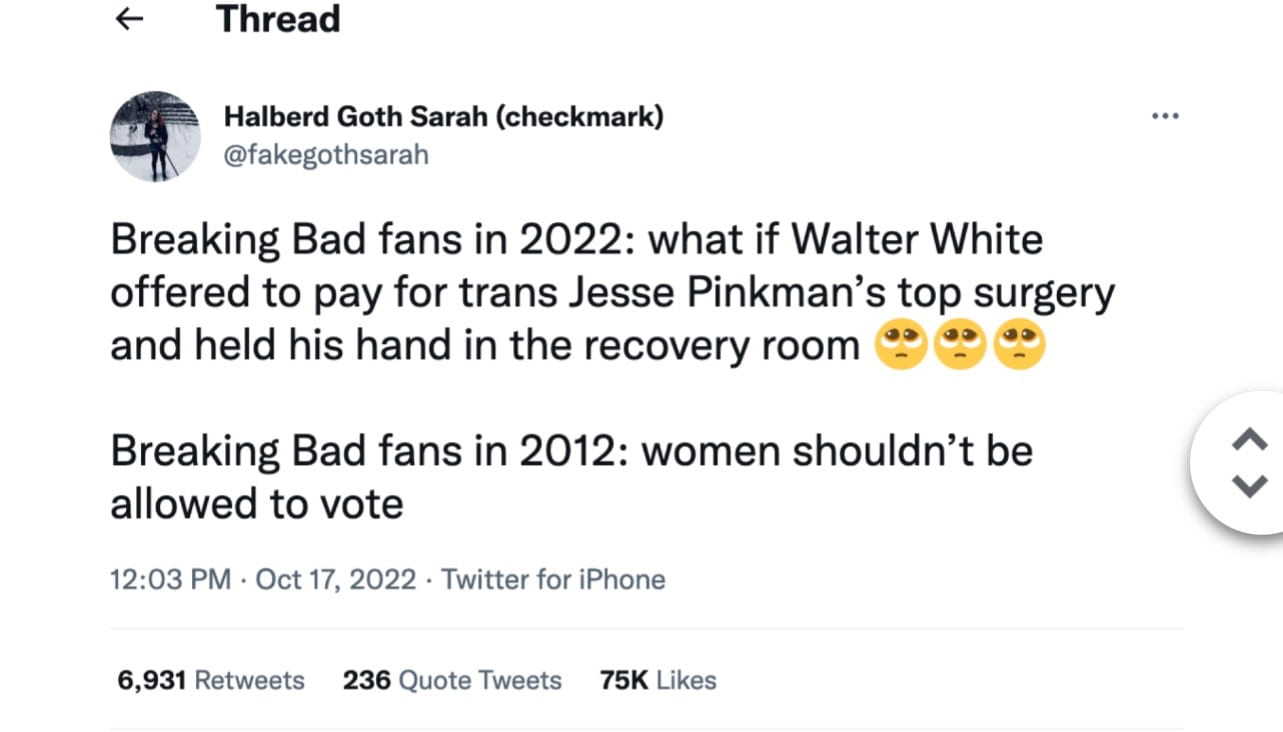
Thankfully, the emergence of the #MeToo movement and the broader examination of online misogyny brought about through the Gamergate scandal seem to have broadly pushed this level of bad behavior beyond the pale for many. Although Skyler White hate still persists in certain sections of the fanbase, focus seems to largely have been directed away from her perceived character flaws. As a testament to just how far things have come, the top TikTok under the 14 billion view #BreakingBad is currently a sad edit of Walter taunting Skyler over the phone, suggesting the fans have at least a little more empathy for an incredibly mistreated character. These broader cultural shifts, however, are not sufficient explanation for how the “women shouldn’t be allowed to vote” fans have fallen out of favor, nor do they explain the contemporary resurgence. These answers lies with the show’s significant queer fanbase—more specifically “Breaking Bad”’s transgender fans. As with many, many internet trends, it all started with Tumblr.
In May of 2021 Tumblr account @jadenvargen posted a hand drawn comic of various “Breaking Bad” characters celebrating Jesse getting transmasculine top surgery—referencing a scene where the characters’ friends visit him in the hospital. From there, jokes about Jesse fitting into stereotypes usually applied to younger trans men on Tumblr—mostly surrounding the character’s wardrobe of loud, oversized shirts and hoodies (worn despite the Albuquerque heat), and generally goofy demeanor—began proliferating across the site. Soon, posts about Jesse and his girlfriend Jane, played by Kristen Ritter, resembling a typical t4t (trans for trans) couple began to appear, alongside jokes about the character’s names (Walter White and Jesse Pinkman, along with the blue meth) filling in the pink, white, and blue stripes of the trans pride flag. These characters, Jesse in particular, began to take on a life of their own through the practice of “headcanoning,” which Tumblr user @rpedia defines as “Canon according to the inside of your head. Information that you believe to be true, or use for your character, but may have little to no basis in canon facts and is not widely accepted by the fandom. If it’s explicitly against canon, your character is now an AU (alternative universe) version. If canon has no say in it at all, it’s a headcanon. If the fandom agrees, it’s fanon but go ahead and call it your headcanon.”
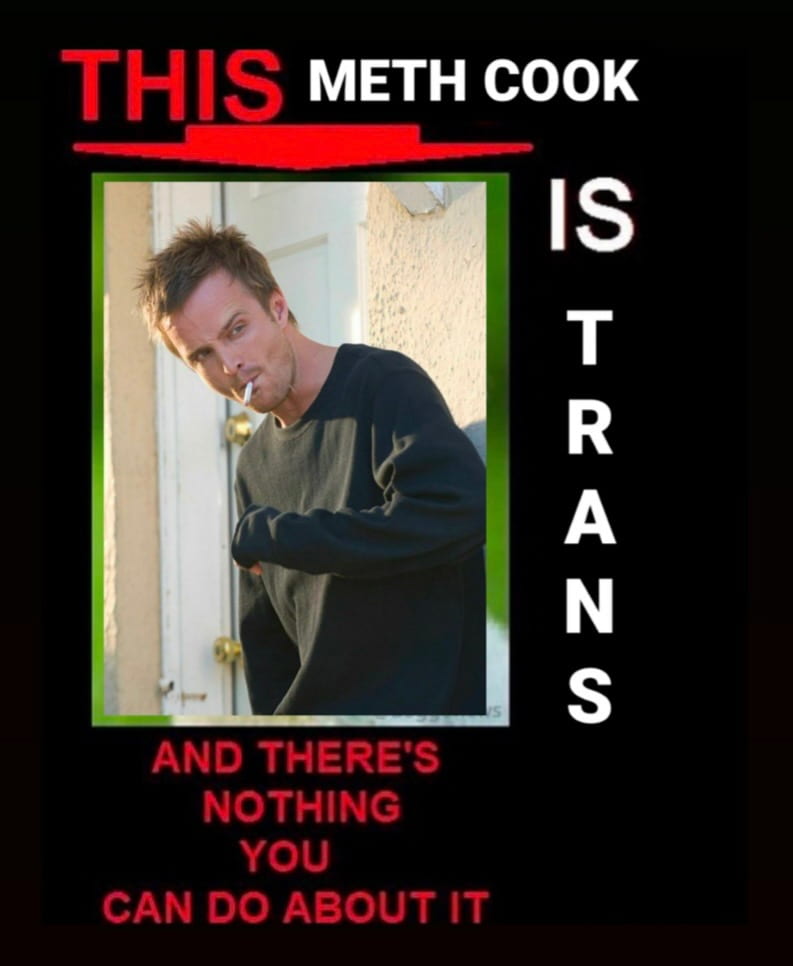
This practice has long been an essential aspect of Tumblr fandom culture, but takes on a particular significance for queer fans. At the height of Tumblr, around 2012–2014, queer media representation remained woefully inadequate. From “Sherlock” to “The Legend of Korra,” queer representation far too often took the form of potential character pairings being dangled in front of fans, only to have that romance tossed to the wayside or barely mentioned by the end of the series run. Queer kids and teenagers understandably longed to see their identities expressed onscreen, and headcanoning became an easy way to slip queerness into media across the board, and prompted further fan engagement online. With a change in attitude, any beloved property could be full of queer representation. As long as enough people find a headcanon engaging, even a property like “Breaking Bad”—with all its grit and machismo—could develop a consistent queer fanbase.
Headcanoning represents an altogether different approach to media, one that adheres neither to authorial intent nor a close reading of the text itself. Instead, the practice can feel like a near-complete disjunction between a text and its characters, where consumers then place them in an amorphous, paratextual space. There, characters are reduced to their most basic facets—most commonly appearance or catchphrases—and reshaped to fit the consumer’s canon. Fanfiction, fan comics, and memes are the domain of the headcanon, where imagined queerness is projected onto the hollow frames of characters. Jesse, who demonstrates clear homophobia onscreen, can become a philosophizing queer icon, Gus can become a friend to gays everywhere, and Mike can advise you on how to get top surgery. There is an aspect of play here—characters become intellectual dolls, limited only by the consumer’s imagination. This isn’t to say that this aspect of the practice of headcanoning should be cause for writing it off as teens messing around online. Headcanoning is a significant way fandoms interact with their respective properties, and, as anyone who has lived through the Marvel Era can tell you, fandoms can make or break a franchise.
Personally, I find headcanoning to be a fun, engaging way to interact with all kinds of media, particularly media that lacks the kinds of representation that are meaningful to me. I have no intention of moralizing this practice; I don’t think that headcanoning is a marker of the death of media literacy. There are much more significant signs of that process elsewhere. That being said, this treatment—particularly the ways in which this practice glosses over anything that doesn’t fit into the Tumblr queer’s soft and familiar vision of the world—sets off a few red flags for me. Shows like “Breaking Bad” are messy and uncomfortable for a reason, and this practice of decoupling characters from the text, in my mind, is ultimately a disservice to all involved. While we might want to see happy endings for Jesse and Jane, the show’s commitment to gritty violence and dark themes gives all the more weight to brief moments of actual happiness. As much as it pains me to admit, the show’s original fans were onto something.
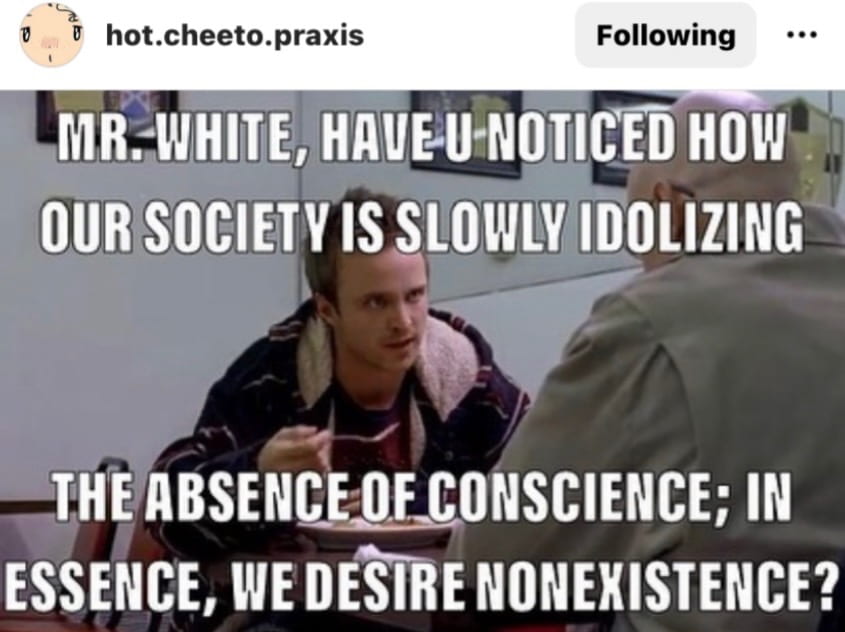
Does “Breaking Bad” condone misogyny? That question is beyond the scope of this essay. What I find both more interesting, and more relevant, is the show’s conflicted messaging around the kinds of toxic masculinity that produced and attracted the misogyny of the show’s original fanbase. Much as Jack Saint proposes Skyler White as a litmus test for fans’ misogyny in his video essay, I propose that how one views Walter is the greatest indicator of what “Breaking Bad” represents to that person. Walter White—underdog hero to some, egotistical villain to others—best epitomizes the at times ambivalent stances showrunners Vince Gilligan and Peter Gould take on hypermasculinity. While the show’s text ultimately condemns Walter as the antagonist of his own narrative, this conclusion is somewhat undermined by his framing throughout the series.
Two scenes in particular stand out to me as most emblematic of this conflict between text and framing, both which represent much of what was so attractive to those original fans. The first scene, from Season 1 Episode 6, has Walter facing off against local cartel leader Tuco Salamanca, played by Raymond Cruz. As the two bargain over meth prices, Walter seems completely resistant to the cartel’s multitude of scare tactics, standing confidently in a beam of light as Tuco’s lackeys fade into the dark background. As tensions come to a head, Walter slams a piece of what the viewer takes to be meth to the ground (“fulminated mercury” he explains later), as the camera cuts to a series of Michael Bay-esque explosions. “You’ve got balls,” Tuco concedes, concluding the deal in favorable terms for Walt, who exits the scene through a parting crowd of astonished gangsters. While this scene ultimately marks a crucial step in his lethal relationship with the cartel, nearly getting his family killed later down the road, it also unambiguously idealizes Walter’s domination of Tuco in the field of hypermasculine competition. From the heroic beam of light, to the parting of the gangsters, this scene is framed as a moment of pure underdog triumph, one that has no qualms about playing up Walter’s ego.
The second scene, arguably one of the most famous of the show—the infamous “I am the danger” monologue—comes in the sixth episode of the fourth season. By now, Walter and Skyler’s marriage is crumbling as she puts together the pieces of his drug dealings, leading to a dramatic confrontation over the safety of the family. As Walter belittles her concerns and shouts about how much he’s dominated his enemies in the drug world, the camera gives us Skyler’s POV—looking up at Walt’s now-towering figure. While there are a few brief moments to give us a glimpse into Skyler’s conflicted reaction, Walt’s newfound machismo dominates the scene. While he is unequivocally, knowingly lying and gaslighting here, he is framed as the “winner” of this scene, symbolically brushing off Skyler’s hysterical accusations. Once again, the text of the scene shows us a lying man, berating his wife for worrying about their family’s safety, which would suggest a condemnation of Walt’s machismo. Certainly, there is a way to read this scene as Walt trying to convince both Skyler and himself of his power and realizing just how far he’s leaning into his persona, as evidenced by his faltering at the end of the monologue. The narrative ambiguity of the scene, however, seems to have left the door open for the misogynistic Redditor crowd, who instead have read this scene as a prime example of Walter justifiably dunking on his concerned wife. Where some might view the “I am the danger” monologue as an almost satiric exaggeration of the hypermasculine provider archetype, the same exaggeration that allows a satirical reading became a point of celebration for the original fans. As Jack Saint concludes in his video, this extreme performance of masculinity is what stuck with that amorphous group of Redditors and 4channers, who saw “men aspiring to be alpha males,” rather than egotistical liars. This narrative, of Walter White as an underdog succeeding in a world that wants him to stay down, is supported somewhat in the early seasons. However, by the time the viewer arrives at this scene, Walter has far surpassed the social challenges that plagued him in the early seasons. Skyler’s refusal to celebrate her husband’s success in the drug world, in the eyes of the fans, supported the idea that Walt was in fact still being oppressed, in this case by his nagging wife. To that original crowd of incels and men’s rights activists, “Breaking Bad” was not a cautionary tale at all, but a heroic story of a beaten-down underdog asserting masculine dominance over a society that didn’t celebrate him enough.
Was this violently toxic group of people reading “Breaking Bad” the ‘right’ way? I don’t think so. Misogyny and the ‘alpha male’ mindset deserve no place in the show’s fandom, and actively contribute to the kinds of communities who find it appropriate to send death threats to actresses. Nor am I equating these people with more Tumblr-aligned fans of today. I think that ‘queering’ “Breaking Bad” is hands-down a more fun, and less problematic, way to appreciate a series that has taken its rightful place among the greatest ever produced. But as we enjoy transmasc Mike and nonbinary Saul Goodman, it is crucial not to lose sight of the very real issues present in the show that fostered such a toxic community. Ultimately, “Breaking Bad”’s new fans are interacting with the show in a fundamentally different way, where any ambiguities in its messaging are rendered essentially irrelevant. In the Tumblr world, Walter White’s status as hero or villain has no real meaning. While memes like the “Jesse What the Fuck are You Talking About” format cast Walt as a somewhat clueless boomer, any question of his morality, whether aspirational or not, is not a particular topic of interest. I love “Breaking Bad”, but I think we need to meet the show where it’s at, problematic politics and all. The Tumblr treatment, and the paratextual playspace it creates, cannot be the beginning and end of genuine appreciation for the show. We have to sit side-by-side with t4t Jesse and Walter White the alpha male, to view the show in its textual and paratextual entirety.

